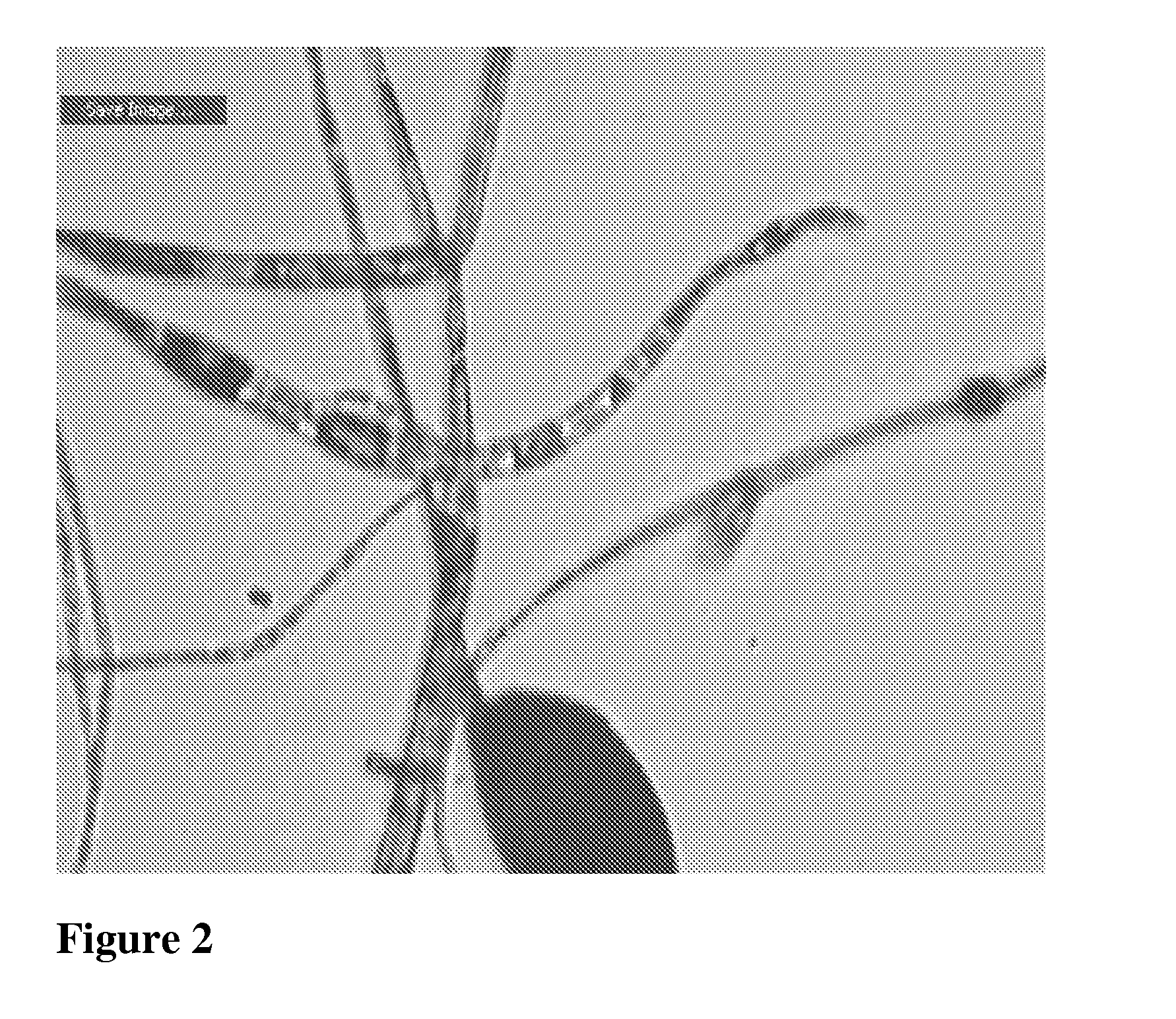Fibers Including Nanoparticles And A Method Of Producing The Nanoparticles
a technology of fibers and nanoparticles, applied in the field of nanoparticles, can solve the problems of inability to specifically adapt mills currently used in milling applications to form nanoparticles, inability to introduce contaminants from outside sources, and nanoparticle properties, etc., to achieve the effect of large nanoparticle production, excellent photoluminescent properties, and minimal steps
- Summary
- Abstract
- Description
- Claims
- Application Information
AI Technical Summary
Benefits of technology
Problems solved by technology
Method used
Image
Examples
example 1
[0048]A silicon composition comprises hydrogen silsesquioxane. The hydrogen silsesquioxane is dissolved in methyl isobutyl ketone in a ratio of 3:1 hydrogen silsesquioxane to methyl isobutyl ketone based on weight. The hydrogen silsesquioxane dissolved in the methyl isobutyl ketone is electrospun onto a silicon wafer, i.e., a collector, to form a plurality of fibers. The electrical potential between the nozzle and the collector is 30 kV. The gap between the nozzle and the collector is 25 cm. The flow rate of the hydrogen silsesquioxane dissolved in the methyl isobutyl ketone through the nozzle is 1 mL / min. The fibers are spun for about 1 minute. The fibers are pyrolyzed by heating the fibers from ambient temperature at a rate of 25° C. / min until the fibers reach a temperature of 1,200° C. The fibers are heated at the temperature of 1,200° C. for one hour. The fibers are pyrolyzed in an environment comprising nitrogen gas and hydrogen gas, which are inert and free of oxygen, to form ...
example 2
[0049]A silicon composition comprises hydrogen silsesquioxane. The hydrogen silsesquioxane is dissolved in methyl isobutyl ketone in a ratio of 3:1 hydrogen silsesquioxane to methyl isobutyl ketone based on weight. The hydrogen silsesquioxane dissolved in the methyl isobutyl ketone is electrospun onto a silicon wafer i.e., a collector, to form a plurality of fibers. The electrical potential between the nozzle and the collector is 30 kV. The gap between the nozzle and the collector is 25 cm. The flow rate of the hydrogen silsesquioxane dissolved in the methyl isobutyl ketone through the nozzle is 1 mL / min. The fibers are spun for about 1 minute. The fibers are pyrolyzed by heating the fibers from ambient temperature at a rate of 25° C. / min until the fibers reach a temperature of 1,500° C. The fibers are heated at the temperature of 1,500° C. for one hour. The fibers are pyrolyzed in an environment comprising nitrogen gas and hydrogen gas, which are inert and free of oxygen, to form n...
example 3
[0050]A silicon composition comprises methyl silsesquioxane. The methyl silsesquioxane is dissolved in methyl isobutyl ketone in a ratio of 3:1 methyl silsesquioxane to methyl isobutyl ketone based on weight. The methyl silsesquioxane dissolved in the methyl isobutyl ketone is electrospun onto a silicon wafer, i.e., a collector, to form a plurality of fibers. The electrical potential between the nozzle and the collector is 30 kV. The gap between the nozzle and the collector is 25 cm. The flow rate of the methyl silsesquioxane dissolved in the methyl isobutyl ketone through the nozzle is 1 mL / min. The fibers are spun for about 1 minute. The fibers are pyrolyzed by heating the fibers from ambient temperature at a rate of 25° C. / min until the fibers reach a temperature of 1,200° C. The fibers are heated at the temperature of 1,200° C. for one hour. The fibers are pyrolyzed in an environment comprising nitrogen gas and hydrogen gas, which are inert and free of oxygen, to form nanopartic...
PUM
| Property | Measurement | Unit |
|---|---|---|
| temperature | aaaaa | aaaaa |
| time | aaaaa | aaaaa |
| diameter | aaaaa | aaaaa |
Abstract
Description
Claims
Application Information
 Login to View More
Login to View More - R&D
- Intellectual Property
- Life Sciences
- Materials
- Tech Scout
- Unparalleled Data Quality
- Higher Quality Content
- 60% Fewer Hallucinations
Browse by: Latest US Patents, China's latest patents, Technical Efficacy Thesaurus, Application Domain, Technology Topic, Popular Technical Reports.
© 2025 PatSnap. All rights reserved.Legal|Privacy policy|Modern Slavery Act Transparency Statement|Sitemap|About US| Contact US: help@patsnap.com



